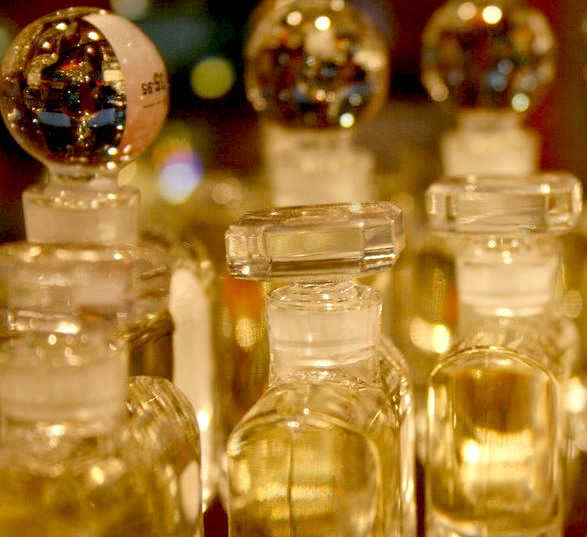
Ambergris
is peculiar to sperm whales, the only large whale to focus on eating
squid with hard beaks that are difficult to digest. This makes sperm
whales, $Billion
Dollar Whales.
Unlike
blubber, Ambergris is a substance
formed in sperm whale intestines, to protect it from sharp squid
beaks. It can be likened to the spittle in oysters
that forms pearls,
except for the different chemical make up. Pearls being hard and round
and Ambergris being irregularly shaped and waxy.
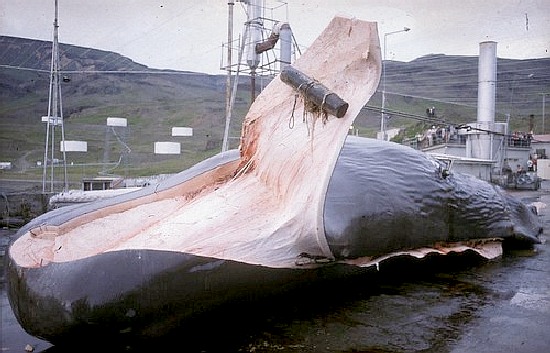
Sperm
whale carcass being stripped of blubber onboard a ship.
Sperm whales eject the intestinal slurry into the ocean where it often floats in the water for years while it hardens and develops a distinctive odour.
In 2006 a couple walking on an Australian beach found a 32-pound chunk of ambergris, which netted them $295,000.
Ambergris, ambergrease, or grey amber, is a solid, waxy, flammable substance of a dull grey or blackish colour produced in the digestive system of sperm whales. Freshly produced ambergris has a marine, fecal odor. It acquires a sweet, earthy scent as it ages, commonly likened to the fragrance of rubbing alcohol without the vaporous chemical astringency.
Ambergris has been highly valued by perfumers as a fixative that allows the scent to endure much longer, although it has been mostly replaced by synthetic ambroxide. Dogs are attracted to the smell of ambergris and are sometimes used by ambergris searchers.
TEN AMBERGRIS FACTS
1. Ambergris is a solid, waxy, flammable substance of a dull grey or blackish colour produced in the intestines of
sperm whales.
2. It's produced by the whale to protect its gut from the very sharp beaks of squid that it feeds on deep down in the ocean.
3. Although called 'whale vomit', it is just as likely probably pooped,
if smaller, rather than vomited.
4. It is excreted hundreds of miles away from land.
5. It can float on the ocean for years before washing ashore.
6. Years of exposure to the sun and salt water transform the waste into a smooth, grey, lump of compact rock which has a waxy feel to it.
7. Freshly produced ambergris has a marine, fecal odor and as it ages, it acquires a sweet, earthy scent.
8. It got its name because it looks like the amber washed up on beaches in the Baltic. Gris comes from the Latin word for grey.
9. It is used in the production of perfume and as a result is extremely valuable.
10. Scientists refer to ambergris as "floating gold" because of this.
Ambergris is formed from a secretion of the bile duct in the intestines of the sperm whale, and can be found floating on the sea or washed up on coastlines. It is sometimes found in the abdomens of dead
sperm
whales. Because the beaks of giant squids have been discovered within lumps of ambergris, scientists have theorized that the substance is produced by the whale's gastrointestinal tract to ease the passage of hard, sharp objects that it may have eaten. The sperm whale usually vomits these, but if one travels further down the gut, it will be covered in ambergris.
Ambergris is usually passed in the fecal matter. It is speculated that an ambergris mass too large to be passed through the intestines is expelled via the mouth, leading to the reputation of ambergris as primarily coming from whale vomit. Ambergris takes years to form. Christopher Kemp, the author of Floating Gold: A Natural (and Unnatural) History of Ambergris, says that it is only produced by sperm whales, and only by an estimated one percent of them. Ambergris is rare; once expelled by a whale, it often floats for years before making
landfall. The very small chance of finding ambergris, and the legal ambiguity involved led perfume makers away from ambergris and led chemists on a quest to find viable alternatives.
Ambergris is primarily found in the Atlantic Ocean and on the coasts of South Africa, Brazil, Madagascar, the East Indies, The Maldives, China, Japan, India, Australia, New Zealand, and the Molucca Islands. Most commercially collected ambergris comes from the Bahamas in the Atlantic, particularly New Providence. Fossilised ambergris from 1.75 million years ago has also been found.
Ambergris is found in lumps of various shapes and sizes, usually weighing from 15 grams (1⁄2 ounce) to 50 kilograms (110 pounds), sometimes more. When initially expelled by or removed from the whale, the fatty precursor of ambergris is pale white in colour (sometimes streaked with black), soft, with a strong fecal smell. Following months to years of
photo-degradation and oxidation in the ocean, this precursor gradually hardens, developing a dark grey or black colour, a crusty and waxy texture, and a peculiar odour that is at once sweet, earthy, marine, and animalic. Its scent has been generally described as a vastly richer and smoother version of isopropanol without its stinging harshness.
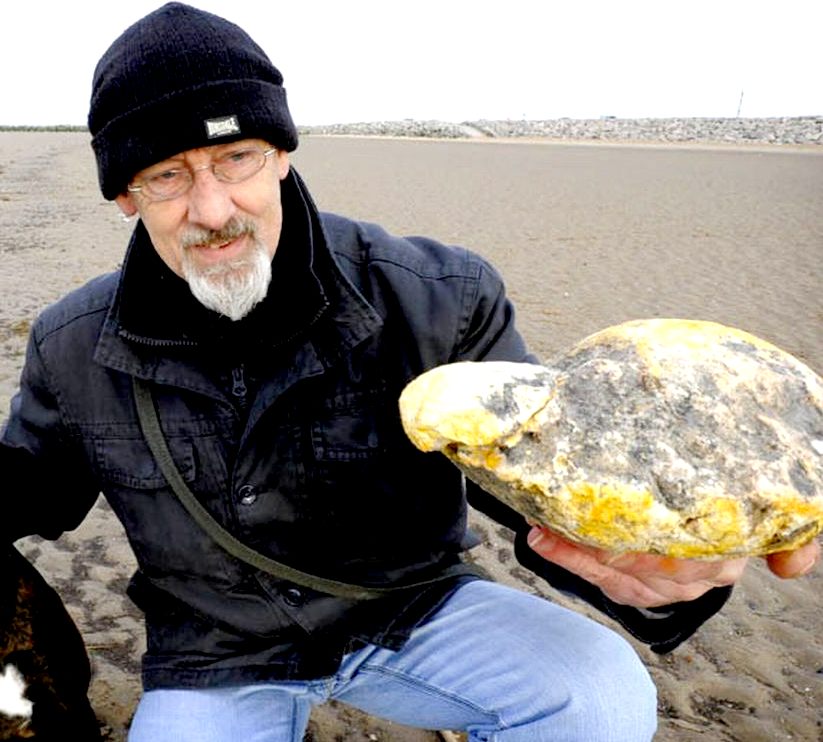
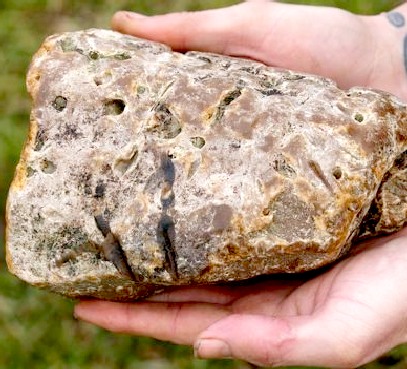
Lucky
beach finds, walkers spotted these hardened whale excretions, said to be
worth a pretty penny to perfumers.
PERFUMERY
Ambergris has been mostly known for its use in creating perfume and fragrance much like musk. Perfumes can still be found with ambergris. Ambergris has historically been used in food and drink. A serving of eggs and ambergris was reportedly King Charles II of England's favorite dish. A recipe for Rum Shrub liqueur from the mid 19th century called for a thread of ambergris to be added to rum, almonds, cloves, cassia, and the peel of oranges in making a cocktail from The English and Australian Cookery Book. It has been used as a flavoring agent in Turkish coffee and in hot chocolate in 18th century Europe. The substance is considered an aphrodisiac in some cultures.
Ancient Egyptians burned ambergris as incense, while in modern Egypt ambergris is used for scenting cigarettes. The ancient Chinese called the substance "dragon's spittle fragrance". During the Black Death in Europe, people believed that carrying a ball of ambergris could help prevent them from contracting plague. This was because the fragrance covered the smell of the air which was believed to be a cause of plague.
During the Middle Ages, Europeans used ambergris as a medication for headaches, colds, epilepsy, and other ailments.
NEAR EXTINCTION
From the 18th to the mid-19th century, the whaling industry prospered. By some reports, nearly 50,000 whales, including
sperm whales, were killed each year. Throughout the 1800s, "millions of whales were killed for their oil, whalebone, and ambergris" to fuel profits, and they soon became endangered as a species as a result. Due to studies showing that the whale populations were being threatened, the
International Whaling Commission instituted a moratorium on commercial whaling in 1982. Although ambergris is not harvested from whales, many countries also ban the trade of ambergris as part of the more general ban on the hunting and exploitation of whales.
Urine, faeces and ambergris (that has been naturally excreted by a sperm whale) are waste products not considered parts or derivatives of a CITES species and are therefore not covered by the provisions of the Convention.
IN LITERATURE
In chapter 91 of Herman Melville's
Moby-Dick (1851), Stubb, one of the mates of the Pequod, fools the captain of a French whaler (Rose-bud) into abandoning the corpse of a sperm whale found floating in the sea. His plan is to recover the corpse himself in hopes that it contains
ambergris. His hope proves well founded, and the Pequod's crew recovers a valuable quantity of the substance. Melville devotes the following chapter to a discussion of ambergris, with special attention to the irony that "fine ladies and gentlemen should regale themselves with an essence found in the inglorious bowels of a sick whale."
In "A Romance of Perfume Lands or the Search for Capt. Jacob Cole", F. S. Clifford, October 1881, the last chapter concerns one of the novel's characters discovering an area of a remote island which contains large amounts of ambergris. He hopes to use this knowledge to help make his fortune in the manufacture of perfumes.
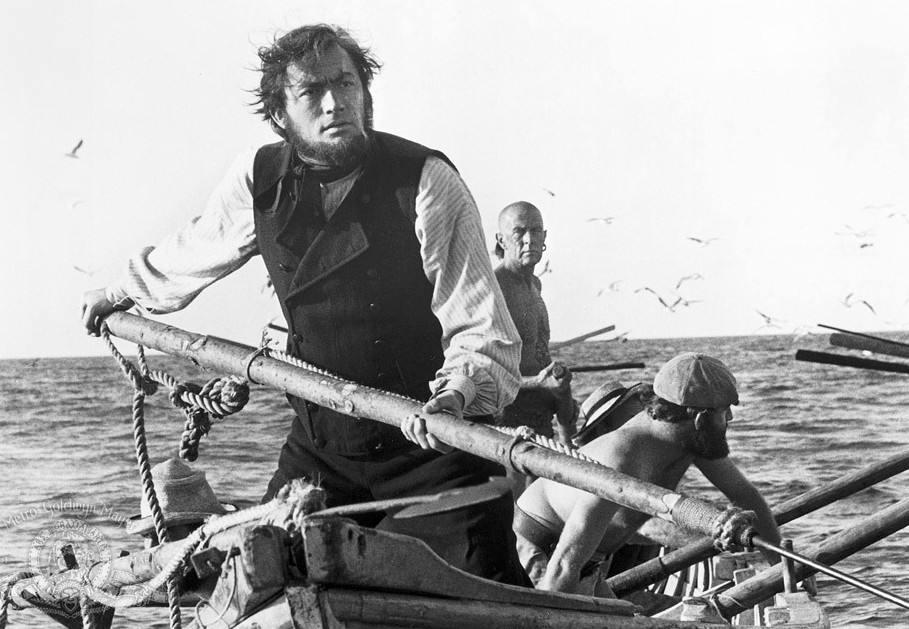
Gregory
Peck gives an outstanding performance as Captain
Ahab, the obsessed
master of the Pequod, in the 1956
movie: Moby Dick.
A
BIT OF MOBY HISTORY
Moby
Dick is the story of a great white
sperm whale that fought back at
whalers who tried to harpoon him. The idea came to Herman Melville after
he spent time on a commercial whaler, where stories abounded of the
sinking of the Essex in 1821 and Mocha
Dick, a giant sperm whale that sank around 20 ships, before being
harpooned in 1838.
Moby
Dick has inspired a great many adaptations, the same basic story
finding its way into the making of four films and two television
adaptations.
In
addition there are many comics and illustrated volumes, adapted from the
original, one of which is the emerging graphic novel version of a large
humpback whale called Kulo Luna.
Kulo
Luna is not as big as the whales depicted in Herman
Melville's Moby
Dick, but she has a diamond encrusted heart of gold, only attacking
whaling ships that present a danger to herself or her friends. She
becomes a $Billion
Dollar Whale.
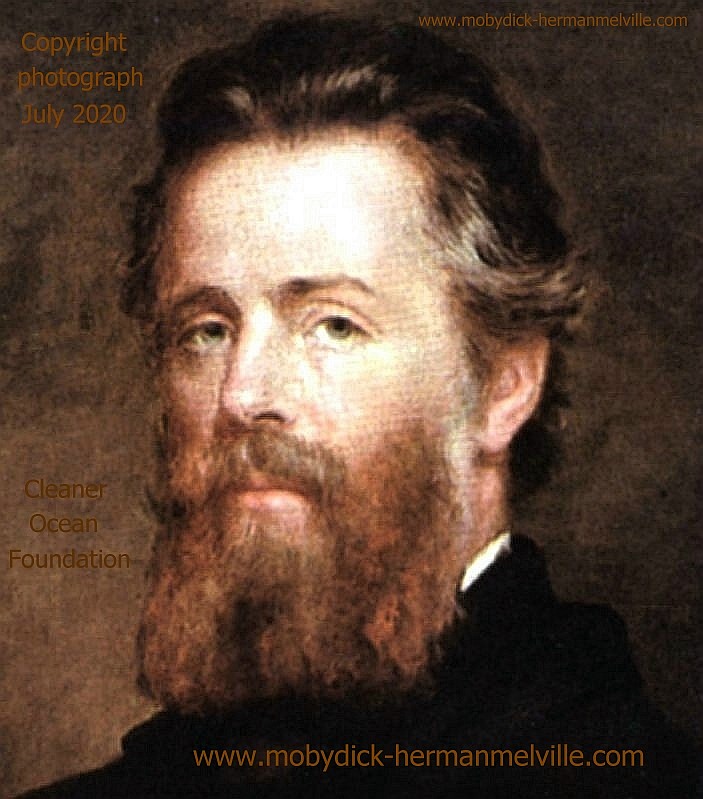
Herman
Melville was the author of what we'd now consider an illegal activity,
the commercial hunting of whales for oil and meat.
Please use our
A-Z INDEX to
navigate this site





